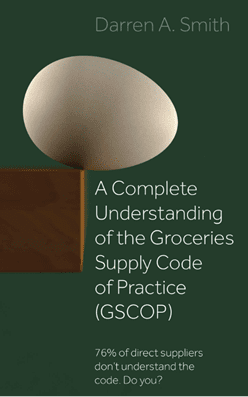Supplier Management is Not Only for Christmas….
David and Goliath
Your day to day interactions with UK supermarket buyers may feel like going a couple of rounds with a boxing heavyweight. Lots of heavy blows, very one-sided, and little chance of getting anything concrete out of it for you and your business. However, believe it or not, there is usually a quite well thought through and planned strategy. One that they adopt towards you and your competitors in the category. What you see day-to-day is the tactical implementation of that strategy from a buyer who is only focused on a one year, ‘I must hit my budget targets’ timeframe.
Above the buyer will be a category controller and a category director. Their job is to look slightly beyond those rigid (but still oh so vital) budget tramlines to longer-term KPIs. These can be customer engagement, market share and sustainability. And believe it or not, that includes supplier and supply chain sustainability!
In highly brand dominant categories, their supplier management strategy will focus on how to squeeze and play off the various brand players. And how to do this for maximum margin and investment whilst still maintaining adequate shopper choice. For example, soft drinks, soap powder, crisps and snacks and chocolate.
In more own brand dominated categories, the strategy is more orientated around maintaining a sustainable, quality led, and innovative supply base. One that they can still squeeze for margin and investment! For example, ready meals, yoghurts and desserts and cooked meats.

The Supplier Management Account Planning Pyramid
Individual multiple supermarkets will have slightly different models and terminology they use to internally plan their supplier strategies. But a useful ‘catch all’ model is the Account Planning Pyramid. This consists of three layers. With the majority of suppliers managed at the transactional trading terms level rising through the more integrated and structured Joint Business Plan level to the exclusive sunlit upland peak of Strategic Collaboration.
Trading Terms in Supplier Management
At the base trading terms level of strategic supplier management planning the supermarket multiple you supply will have a pretty much purely transactional strategy by which they plan to interact with you. Planning horizons will be pretty short. Regular contact will probably only consist of promotional discussions to their own internal promotional timetable. Annual or bi-annual range reviews plus the inevitable year-end ‘flight-path’ discussions may be the only times you have any meaningful dialogue with them.
From your perspective, you need to ensure that this level of strategic management works as well for you as you can make it. Although you will have very little say in the matter!
GSCOP

You have a legal right in 14 of the largest UK grocery multiples to have a GSCOP compliant Written Supply Agreement. It is important that you have one of these as it sets out your legal trading position with the supermarket in question. Also, it offers you (relatively) significant protection from some of the more extreme ways buyers have devised to extract money and investment from you.
Whilst difficult to fully control, you should aim at this level of trading to have a negotiated, balanced structure of the front and back margin delivery of your products for the retailer. Front margin grows directly in line with sales and doesn’t necessarily encourage proactive volume growth delivery from the retailer by itself. Whereas, a well-structured back margin agreement can be relatively cost-effective. Also, it can directly incentivise the retailer to grow your business with them. Furthermore, be aware of ‘back to zero’ growth agreements that reward the retailer. Whatever they decide to do with your order volumes, always aim for a targeted ‘ladder’ structure with clear hurdles. Ones that they have to exceed to get a reward in terms of back margin.
Many suppliers can trade quite successfully with their supermarket customers at this level. It will often suit suppliers whose customer sales portfolio is quite diverse and evenly split. However, on the downside, you may be unable to get traction on your own trade marketing and customer activation plans which could inhibit your opportunities for growth.
A typical supermarket supplier strategy would trade with between 50% and 70% of their supplier base at this trading terms, transactional level, dependent on the category role within their business
Joint Business Plan (JBP)
The next step up the pyramid is the JBP level. Joint Business Plans come in two very distinct flavours. The genuine ones where the ‘J’ in Joint is respected and forms an integral part of the planning process. Or the false flag JBP where effectively the ‘J’ is replaced by the retailer with an ‘O’ – for ‘Our’ Business Plan.
Buyers often use the vague promise of a Joint Business Plan to tactically position a supplier to extract increased support, investment and margin. These plans have no real ‘J’ in them and need to be seen and treated by suppliers for what they really are – tactical duping by the buyer.
Genuine Joint Business Plans however are something that can help develop and grow your business. They will typical target the classic four ‘P’s of product group marketing – Price (within clear legal constraints), Promotions, Positioning and Product.
Annual Trading Plan

A clear annual trading plan with objectives, targets and timescales for delivery is agreed ahead of the retailer’s financial year. They start with the retailer and supplier regularly reviewing progress, achievement and course correction actions throughout the trading year. There can be clear indicators of whether you truly have a ‘Joint’ Business Plan with them. For example regularity of meetings and proactivity of the buyer in engaging with the plan.
The buyer will negotiate hard to ensure they make the Joint Business Plan work towards the achievement of their annual margin targets. But, you need to equally negotiate forcefully to ensure any margin or investments that are promised are carefully targeted and budgeted to ensure they work for your own trade or business plan. JBP’s can be hugely beneficial for suppliers with a focus on NPD and innovation or with chunky growth targets for their products or brands.
Most buyers, and certainly their superiors, see the huge benefits of having somewhere between 20% and 40% of their category sales volume ‘tied down’ or ‘guaranteed’. With their JBP suppliers tasked with effectively being accountable for a healthy portion of their sales and profit delivery targets.
Strategic Collaboration in Supplier Management
Strategic collaboration is rarely tactically cynically exploited by buyers. At this level, they recognise the long-term strategic value that the supplier brings to the category and/or the wider business. As well as Strategic Partner terms such as Indispensable Business Partner or Strategic Supplier are often used. This represents the very highest level of supplier and retailer engagement. Aside from vertical integration or ownership of a supplying business by the retailer, which is rare in the UK market. Morrisons business model being the notable exception.
Plans are drawn up and jointly agreed usually over at least a two-year time frame if not three to five years. In these times of data-rich shopper insight, the plans usually target long term sustainable shopper activation, engagement and most importantly loyalty metrics.
Collaboration & Integration
Collaboration and integration assume new levels of intensity. The plans will be highly detailed with very clear joint objectives and targets. Cross-functional teams from both retailer and supplier will engage together on specific projects towards to delivery of the joint objectives.
A retailer will have relatively few suppliers at this highest of levels. Mainly because of the time and manpower investment needed to effectively manage this level of relationship. Most Strategic Collaboration suppliers will be ‘cannot do without’ own brand suppliers producing a large proportion of a retailer’s volume in a particular category. Often from retailer specific dedicated factories or plants within factories.

Large scale brand leading suppliers can also (but relatively rarely) feature as part of a retailers’ Strategic Collaboration supplier base. At this level, the retailer will demand specific, bespoke investment in people, products and promotions. This means it becomes a very tricky juggling act for a big brand player with market-wide exposure to pull off successfully.
It is often by the formation of (almost) autonomous retailer-specific business units that such a relationship does succeed. In some cases, integration is taken so far as for the supplier to have ‘implants’ working within the retailer.
Whilst varying by category and in particular by the amount of own-brand products within the category retailers may have between 10% and 20% of their volume dedicated to these collaborative level suppliers.
The ‘Washing Machine’ Spin Cycle
Some retailers are overt in their communication to suppliers as to exactly where they stand in their strategic plans. Most if not, all have models. Usually, a four-box Boston grid brings these to life. Furthermore, different nomenclatures are used. But most terminology usually revolves around Invest/Divest, Grow/Shrink or Engage/Distance.
Indifference
Firstly, the lowest level of ‘spin’ in the cycle of supplier management is ‘Indifference’. The retailer is indifferent to the supplier’s business. Levels of collaboration are low with few contact points with the business. And also, relatively infrequent engagement in meetings or reviews. Friction is also very low, meaning little positive or negative business development discussions about growth, margin or investment. Suppliers stuck in this quadrant are ‘below the radar’ of the buyer. This is sometimes not a bad place to be – especially at a retailer’s year-end!
This quadrant clearly relates to the transactional level of the Account Planning Pyramid.
Maximum Performance
As suppliers grow in size and importance to the retailer, the buyer or the category they outgrow the ability to be placed in the Indifference box and come onto the Buyers ‘radar’. Clearly, the place to be or the place to aim for is the top right-hand quadrant of the model – Maximum Performance.

Here levels of Collaboration are very high. The retailer wants to engage with the supplier on many levels and in-depth and across the two respective businesses. Friction is also high. But it is a positive friction that creates positive forward momentum energy that gets things done and targets achieved. This quadrant typically reflects those suppliers with detailed, genuine Joint Business Plans. Or those at the level of Strategic Collaboration
Becalmed
As a supplier, you may aim for and achieve maximum performance. But, with a retailer, nothing always necessarily lasts forever! This is the retailer’s supplier ‘washing machine’ spin cycle in action.
The first signs of you being ‘spun out’ are when levels of friction with the retailer begin to drop off. For example, there is less engagement, less going on, less energy, and urgency from the retailer towards the supplier. Scheduled meetings are cancelled or missed on repeated occasions with few or no excuses or reasons. Competing suppliers are seen to start gaining traction in the account with new lines and promotional activity and trade marketing activation. Thus, your business with the retailer starts to stutter and stall. It becomes becalmed – a potentially very dangerous place to be because you may be on your way to Conflict.
Conflict
Conflict is an aggressive stance rather than being positive and proactive. This is implied by the name when the buyer decides that there is more value to be extracted from the supplier in terms of investment and/or margin from adopting a confrontational. As a supplier, you drop out of the top section of the ‘washing machine’ and are spun into direct conflict.
Levels of Collaboration disappear. They manage you in a highly transactional way. This means levels of friction rocket and ratchet up in a highly negative, confrontational and potentially aggressive way. With outrageous demands and carefully (to stay within the GSCOP law) worded, implied threats.
How the ‘Spin Cycle’ in Supplier Management Works Most Effectively

The retailers ‘washing machine’ spin cycle strategy works most effectively in categories with relatively few, large suppliers. Those with brands or product range that shoppers will happily switch and substitute between. Classic categories that retailers employ the ‘spin cycle’ technique on are seasonal confectionery, beer and impulse.
You can actually see the ‘spin cycle’ in action in-store. Look at Easter at which of the big three confectionery brands are stacked up in which retailers front of store. You will quickly see which retailer has which supplier at maximum performance and which is in conflict. Return at Christmas and you will almost always see that the retailers have ‘spun’ the machine. A different branded manufacturer will have the huge front of store stacks of their Christmas confectionary tubs.
Similarly, in beer, look at which of the big four beer brands get prime stack displays during the summer World Cup or European Championships. Then see how the brands ‘spin’ around when it comes to the huge, crucial Christmas trading period
Final Thoughts on Supplier Management
As a supplier, you are not a master of your own destiny. That is when it comes to how you will be managed strategically or tactically by one of the big multiple grocers. Their strategic decisions will determine how they manage you and your business. However, being aware that there is usually a thought through plan, is of huge potential value. A plan that it is possible to move between layers of the pyramid or around the washing machine,
Understand what makes them allocate you to a particular level or box. Then, make plans to either move to a better level or consolidate your preferential position.
Your ability to proactively recognise and plan for how you will be managed will have a direct impact on the success of your business.



